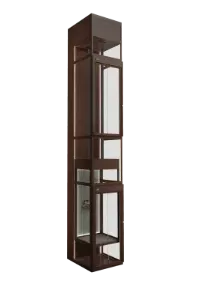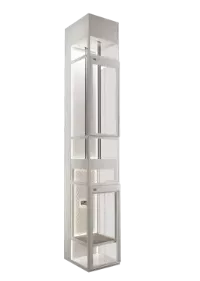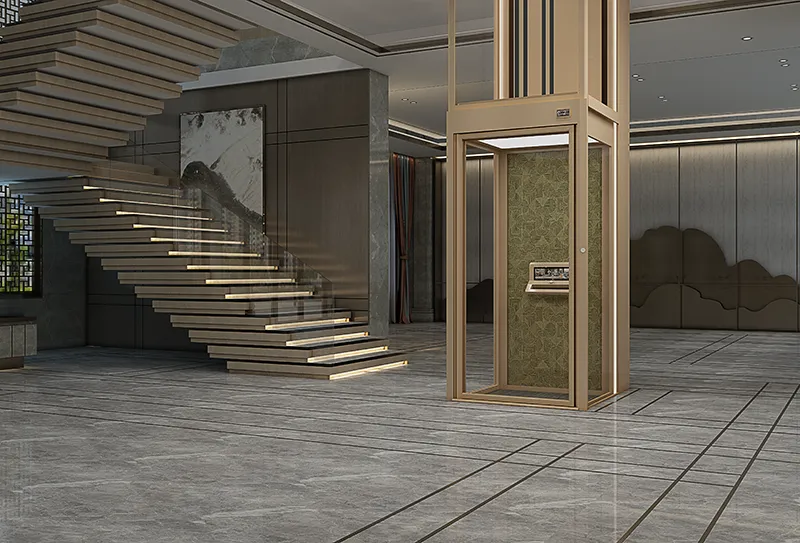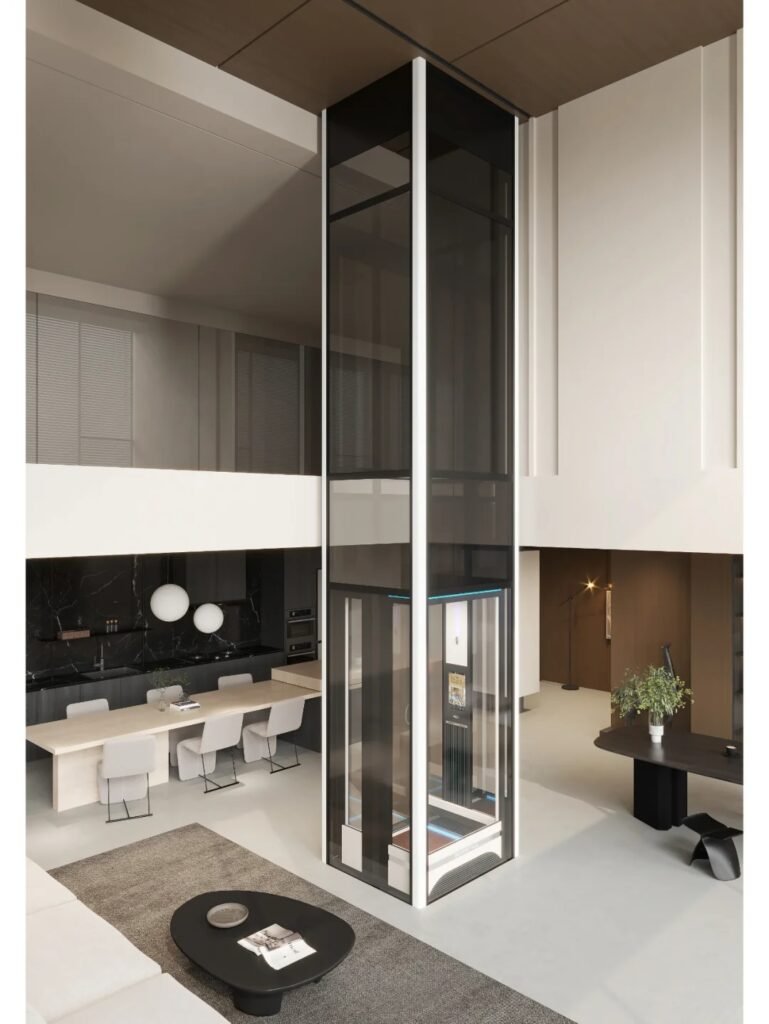If you’re early in planning, start with our free layout check or explore our Traction Gantry (Backpack) Elevator for panoramic designs in limited shafts.
1) Quick Comparison Table
| Factor | Traction Home Elevator (Gearless MRL) | Hydraulic Home Lift |
|---|---|---|
| Best for | 2–5 floors, frequent daily use, energy-efficient homes | 1–3 floors, tight headroom, value-oriented installs |
| Space | Shallow pit; typical headroom moderate; no machine room (MRL) | Shallow pit; low headroom workable; small machine cabinet for pump |
| Ride & Noise | Very smooth, quiet in-car; minimal machine noise | Smooth ride; pump noise must be isolated |
| Energy | Lower (counterweight helps; optional regen drives) | Higher going up; heat in oil; down travel typically not energy-recovering |
| Maintenance | Moderate; rope/sheave wear checks | Oil, valves, seals; environmental care for fluids |
| Speed/Duty | Higher duty; better for frequent multi-trip days | Low-to-medium duty; fine for light usage |
| Upfront Cost | Generally higher for premium gearless systems | Often lower initial equipment cost |
| Total Cost (5 yrs) | Often lower, due to energy & maintenance savings | Similar or slightly higher if used daily |
| Panoramic/Glass | Excellent fit; quiet drive suits open shafts | Feasible; acoustic isolation recommended |
| Power Outage | Battery rescue or manual lowering packages | Manual/valve-based lowering simple & proven |
2) How Each System Works
Traction (Counterweighted, Gearless MRL)
A counterweight balances most of the cabin mass. A compact gearless machine drives ropes/belts over a traction sheave; no separate machine room is needed (MRL). The counterweight reduces motor load, improving energy efficiency and ride quality.
Hydraulic (Pump, Valve, Cylinder)
A power unit pumps hydraulic fluid to move a piston and lift the car; descending is controlled by valves. The system is mechanically simple and tolerant of tight headroom, but upward travel draws more power and fluid management needs attention.
3) Space & Power Requirements
- Pit & Headroom: Both techs can work with shallow pits and moderate headroom in homes. Hydraulic often tolerates lower headroom; traction MRL minimizes machine-room needs.
- Machine Room: Traction MRL = none. Hydraulic = compact cabinet for pump/valve (locate away from bedrooms for noise).
- Power: Modern home traction can run on single-phase with optimized drives; hydraulic may need higher surge capacity when lifting.
4) Ride Comfort & Noise
Traction cabins feel exceptionally smooth, especially with gearless motors and fine motor control. Hydraulic rides are also smooth but the pump startup can be audible; good isolation and cabinet placement keep noise under control.
5) Safety & Compliance
Both technologies meet residential safety codes when properly engineered and installed: door interlocks, overspeed/rollback protection, emergency lowering, two-way comms, lighting, and safe landings. Choose suppliers offering verified compliance, factory testing, and documented rescue procedures.
6) Energy Use & Environment
- Traction: Counterweight offsets car weight → lower lift energy; many systems support regenerative drives to cut consumption further.
- Hydraulic: Draws more power on up runs; heat builds in fluid; use eco-fluids and proper coolers where climate is hot.
7) Costs & 5-Year TCO
Indicative only — varies by load, travel height, finishes, and local codes.
- Upfront: Hydraulic often starts lower; traction higher for gearless MRL and premium finishes.
- Energy (5 yrs): Traction typically lower; hydraulic higher with frequent daily use.
- Maintenance (5 yrs): Hydraulic includes oil/seal/valve service; traction focuses on rope/sheave and control checks.
8) Maintenance & Downtime
Traction systems emphasize preventive checks on ropes/belts, bearings, and controls. Hydraulic adds fluid care and leak prevention. With reputable parts and scheduled service, both are reliable in homes.
9) Aesthetics & Glass/Panoramic Options
For open or panoramic shafts, quiet traction drives are favored. Hydraulic can also be used with glass; plan extra acoustic isolation for the power unit. See our Traction Gantry solution for narrow shafts and glass facades.
10) Installation Time & Upgrades
- Lead time: 4–10 weeks typical depending on customization and approvals.
- Install window: Several days to a few weeks based on shaft readiness and finishes.
- Future upgrades: Cabin refresh, door automation, call panels, remote diagnostics packages.
11) Decision Checklist (Print-Ready)
- Floors & travel height (how many trips per day?)
- Pit depth / headroom available (drawings ready?)
- Nearest bedrooms (noise sensitivity)
- Power availability & surge limits
- Glass/panoramic requirement
- Annual energy target (green home?)
- Maintenance preference (oil vs rope/sheave)
- Budget now vs 5-year ownership cost
12) Real-World Scenarios
Scenario A — 3 floors, family of 4, frequent use
Pick: Traction MRL (gearless). Lower energy, quiet, excellent ride comfort. Consider panoramic cabin if stairwell allows.
Scenario B — 2 floors, tight headroom, light use
Pick: Hydraulic. Works well with lower headroom; control pump noise with cabinet placement and isolation.
Scenario C — 4 floors, glass shaft facing living area
Pick: Traction MRL. Quiet drive and smooth ride complement open interiors.
Scenario D — Retrofit in older villa with minimal structural change
Pick: Depends on shaft: If headroom tight → Hydraulic; if space permits and you want lower TCO → Traction MRL.
FAQs
Is traction always more energy-efficient than hydraulic?
Generally yes for daily-use homes because the counterweight reduces motor load. Exact results depend on load/travel, controller, and usage.
Which is quieter inside the cabin?
Modern gearless traction is typically the quietest in-car. Hydraulic is also smooth; keep the pump cabinet away from bedrooms and isolate it acoustically.
What about power cuts?
Both have safe-lowering options. Hydraulic uses manual/valve-based lowering; traction uses battery rescue or manual modes. Ask to see the procedure.
Do both support panoramic glass cabins?
Yes. Traction is often preferred for glass/open shafts due to lower noise at the drive. Hydraulic is feasible with proper acoustic planning.
What’s the typical maintenance difference?
Hydraulic: oil/valves/seals and fluid handling. Traction: ropes/belts, sheave, and controls. A scheduled plan keeps both reliable in homes.
Next step: Send us your floor plans to get a tailored shaft layout and 5-year cost model. Contact our engineering team.






